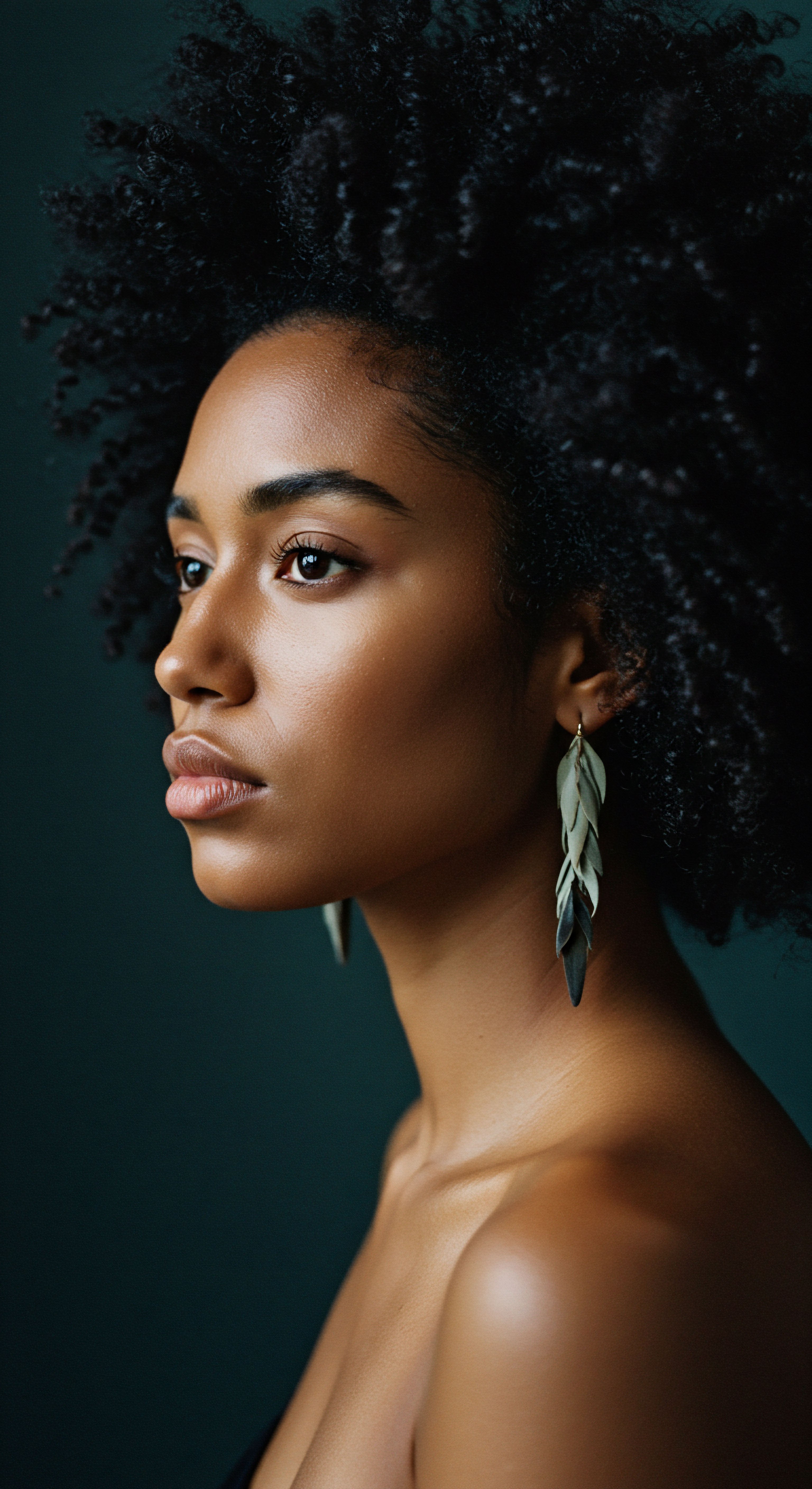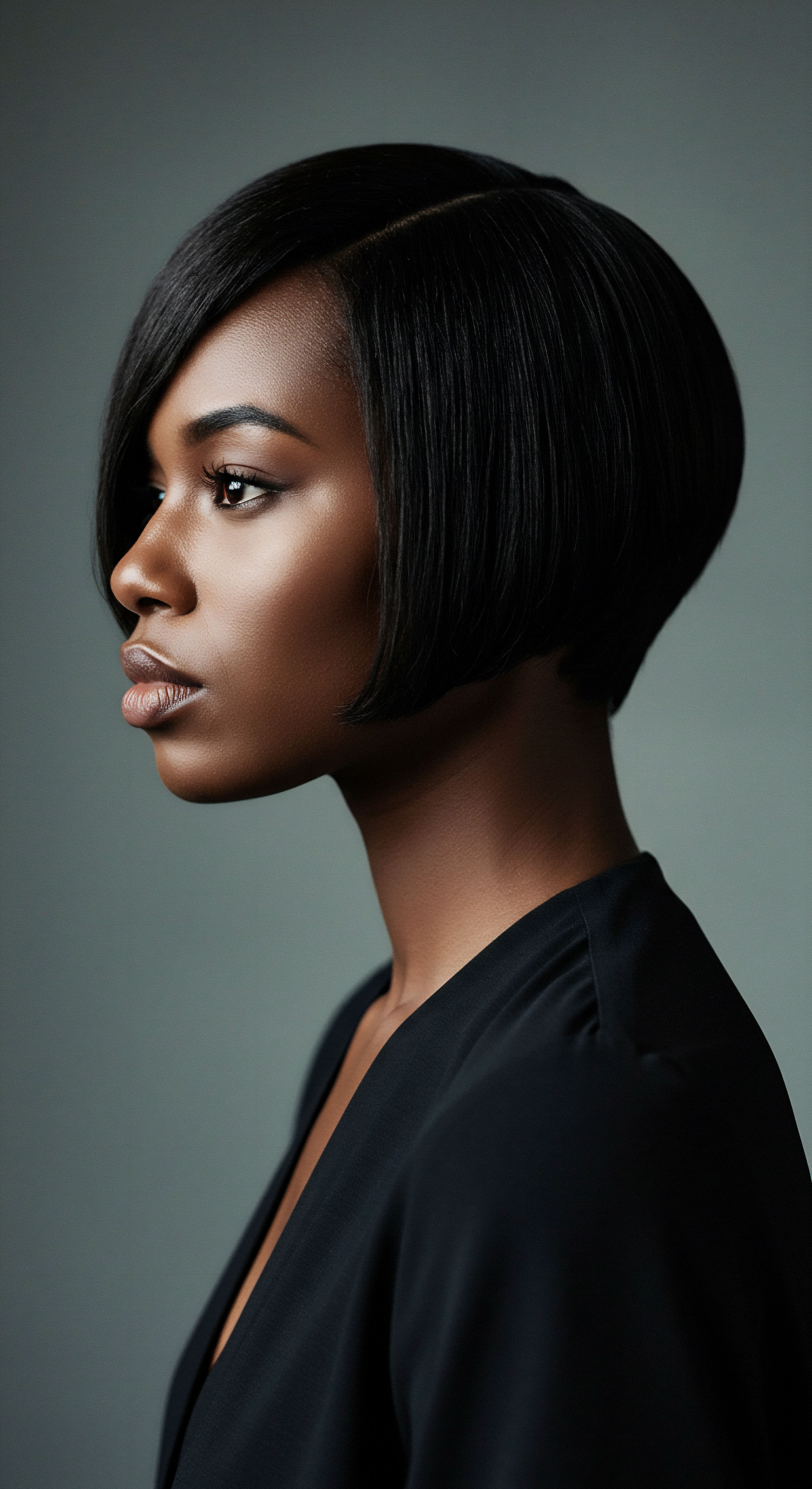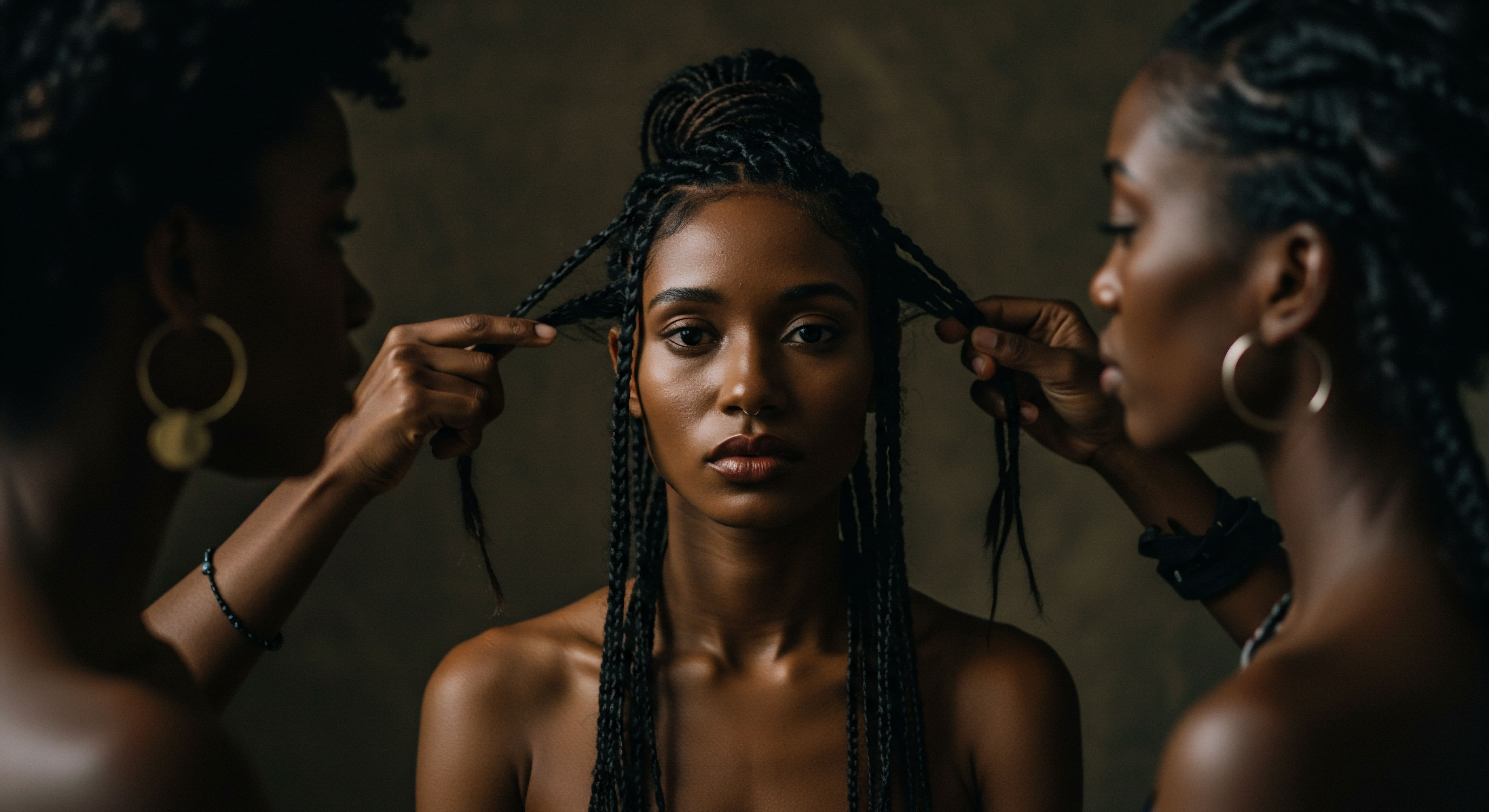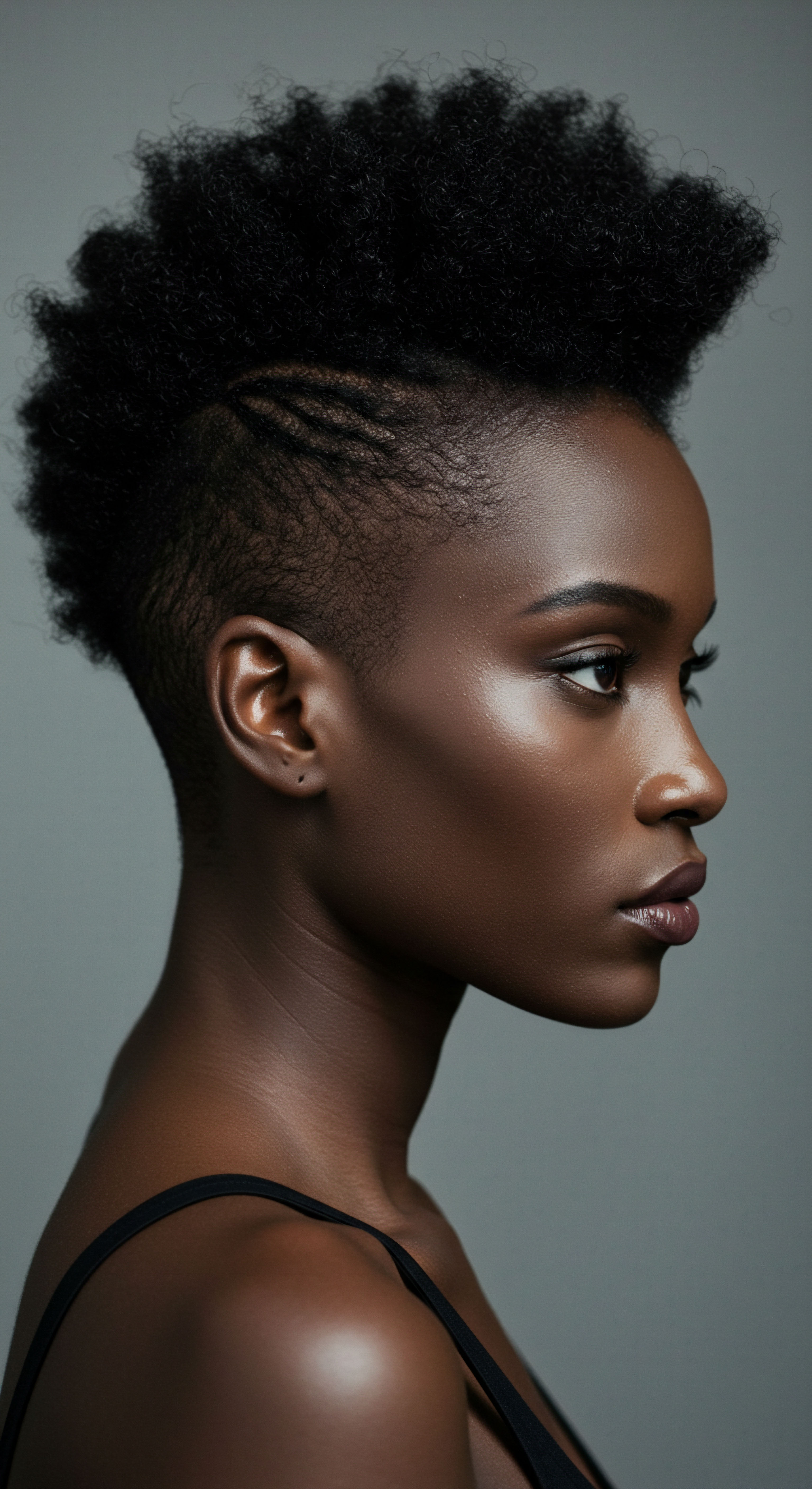
Roots
The whisper of ancient winds often carries secrets, not just of land and sky, but of personal adornment and its deep, abiding meaning. To truly comprehend the profound position hair texture held in early African societies, one must listen beyond mere aesthetics. It was not simply a matter of style or preference; rather, hair served as a vibrant, living testament to identity, a language spoken without words, intricately bound to the very fabric of existence. The coiled, spiraled, and crimped strands were a chronicle, a map of lineage, a declaration of belonging.
Each twist and turn of a natural curl, each deliberate pattern sculpted, conveyed volumes about an individual’s place within their community, their spiritual connections, and their journey through life. This understanding asks us to reconsider our contemporary views, inviting us to see hair as a powerful, communicative medium, a source of grounding presence.

What Made Hair So Central to Identity?
In early African civilizations, hair was seen as a profound extension of the self, a visible signifier of one’s inner and outer world. Its unique texture, far from being a simple biological attribute, became a canvas for expression and communication. This connection ran deep, reflecting an understanding that the body, including hair, was not separate from one’s spirit or social standing. The care given to hair, the styles chosen, and the communal practices surrounding it all underscored its significance.
- Visible Status ❉ Hairstyles often indicated social status, age, marital standing, and even occupation. A glance at a person’s head could reveal their place within the community hierarchy.
- Familial Connection ❉ Hair was sometimes incorporated into family heirlooms or passed down, linking individuals to their ancestors and lineage.
- Spiritual Conduit ❉ Many African cultures believed the head, and by extension, the hair, to be the closest point to the divine, a conduit for spiritual energy and communication with ancestors.
This deeply held belief meant that hair was not treated lightly. It was a repository of personal and communal power, a point of entry for spiritual forces, and a symbol of one’s connection to the cosmos. The practices surrounding hair were therefore imbued with reverence and purpose.

The Earliest Expressions of Textured Hair’s Meaning
Archaeological findings and historical accounts offer glimpses into the antiquity of these practices. In ancient Egypt, for example, elaborate wigs made from human hair, wool, or plant fibers were not only markers of wealth and social standing but also held religious connotations. The elite wore these meticulously crafted pieces, sometimes adorned with gold or beads, as symbols of their connection to the gods and their place in a structured society. This practice extended beyond the living, as wigs and hair extensions were found in funerary contexts, underscoring their importance for the afterlife.
Hair texture in early African societies served as a silent, yet eloquent, language communicating a person’s identity, status, and spiritual connections.
Beyond the Nile, across the continent, varied traditions echoed this sentiment. The Kingdom of Kush, a powerful ancient civilization in Nubia, celebrated natural hair textures, with both men and women styling their hair in curls or tightly bound rows, reflecting their distinct beauty standards and cultural values. These ancient roots show that the reverence for hair texture was not an isolated phenomenon but a widespread understanding woven into diverse African societies.

Ancient Hair Adornments and Their Purpose
The embellishment of hair with various materials was another layer of its significance. Combs, dating back as early as 3900 BCE in Egyptian women’s tombs, were not just tools but decorative objects, often featuring animal motifs that scholars suggest may have been related to ritualistic hunting or festivals. These adornments, whether beads, cowrie shells, or precious metals, further amplified the messages conveyed by the hairstyles themselves, adding layers of meaning related to wealth, marital status, or tribal affiliation.
The very act of adorning hair was often a communal activity, particularly among women. These sessions were not simply about grooming; they were social gatherings, moments for storytelling, for strengthening bonds, and for passing down cultural knowledge from one generation to the next. This communal aspect underscored the shared understanding of hair’s importance, reinforcing its role as a cultural anchor.

Ritual
Consider the quiet rhythm of daily life, the mindful practices that shape our being. In early African societies, the care and styling of hair were far from mundane routines; they were imbued with ritualistic depth, acting as living ceremonies that reaffirmed connections to community, spirit, and self. The practical application of hair knowledge was inseparable from its deeper cultural resonance, a gentle guide to understanding the world and one’s place within it. These were not simply techniques; they were acts of reverence, each motion carrying an echo of ancestral wisdom.

Daily Practices and Their Deeper Meaning
The routines surrounding hair care in early African societies were deeply rooted in cultural beliefs. Unlike modern approaches that often prioritize speed and convenience, these practices were often time-intensive, demanding patience and a careful hand. This dedication reflected the high esteem in which hair was held. The very act of grooming became a moment of contemplation, a quiet dialogue between the individual and their heritage.
For instance, the application of natural oils, clays, and herbs was not solely for conditioning; these substances often carried symbolic properties, believed to protect the hair and the wearer from malevolent forces or to enhance spiritual receptivity. The communal aspect of hair styling, where family members or trusted individuals groomed one another, reinforced social bonds and served as a means of transmitting cultural norms and historical narratives.

Hair as a Communicative Medium
The styles themselves functioned as a sophisticated visual language, communicating a wealth of information about the wearer without a single word being spoken. This non-verbal communication system was a hallmark of many African societies.
- Social Markers ❉ Hairstyles frequently signaled age, marital status, social rank, and even occupation. For example, young Wolof girls might partially shave their heads to indicate they were not of marrying age.
- Life Stage Transitions ❉ Specific styles marked significant life events, such as coming-of-age ceremonies, marriage, or periods of mourning. The Himba tribe, for instance, used distinct dreadlocked styles coated with ochre and butter to denote age, life stage, and marital status.
- Tribal Affiliation ❉ Different ethnic groups had their own characteristic styles, allowing for instant recognition of one’s tribal identity.
The precise execution of these styles was therefore paramount, as any deviation could send an unintended message or even signify a disruption in one’s life or status.

Rituals of Passage and Hair Transformation
Hair transformations were often central to rites of passage, symbolizing profound shifts in an individual’s life. These changes were not merely cosmetic; they were deeply spiritual and communal acts.
The meticulous care and symbolic styling of hair in early African societies served as living rituals, communicating identity, status, and spiritual connections.
For periods of mourning, for example, it was common in some cultures for individuals to neglect their hair or to cut it short, signifying a period of sorrow and detachment from worldly adornment. Conversely, the regrowth of hair, or the adoption of new, elaborate styles, could mark the end of mourning and a return to social life. In the Benin Kingdom, the shaving of hair among men signaled mourning for a deceased Oba, a collective expression of loss and a temporary reduction of status before the symbolic regrowth of a new era.
Consider the intricate hairstyles of the Yoruba people, which often conveyed community roles. Styles like the “Irun Kiko” (thread-wrapping) held meanings related to femininity, marriage, and rites of passage, with elaborate braids often worn by young women during initiation ceremonies to signify their transition to adulthood. The attention given to these details speaks to a society where every strand held a story, every style a purpose.

The Hairdresser’s Sacred Role
The individuals entrusted with styling hair held a special, often revered, position within the community. These were not just artisans; they were confidantes, custodians of cultural knowledge, and sometimes, spiritual guides. The intimate act of hair grooming created strong bonds between the stylist and the client.
The belief that a single strand of hair could be used for spiritual purposes, whether for protection or malevolent spells, meant that only trusted individuals, often close family members, were permitted to style another’s hair. This highlights the sacredness attributed to hair and the profound respect given to those who worked with it. The process of styling could last for hours, even days, fostering deep conversations and communal solidarity.

Relay
To truly comprehend the intricate layers of meaning embedded within hair texture in early African societies, one must look beyond surface interpretations, diving into the confluence of biological form, cosmological belief, and societal structure. The subtle curves of a coil, the robust spring of a kink, were not merely genetic expressions; they were points of convergence for profound philosophical understandings, a living testament to an interconnected worldview where the physical mirrored the spiritual and the individual reflected the collective. This exploration demands a thoughtful pause, a willingness to consider how deeply intertwined every aspect of life once was, how the very strands upon one’s head could speak volumes about their place in the universe.

The Head as a Sacred Axis
Across a multitude of early African belief systems, the head was held as the most sacred part of the body, a vital connection point to the divine and ancestral realms. This reverence directly elevated the significance of hair. It was often considered the ‘crown’ of the body, a sensitive antenna through which spiritual energy flowed and communication with higher powers occurred. This concept transcended mere symbolism; it was an ontological understanding, shaping how hair was treated, styled, and perceived within the community.
The act of grooming, therefore, became a ritual of alignment, a way to honor and maintain this sacred connection. Hairdressers, as mentioned earlier, were not merely stylists but individuals entrusted with this potent point of contact. Their work was seen as a spiritual service, safeguarding the wearer’s well-being and ensuring proper flow of energy.

Hair and Cosmic Alignment
The cyclical nature of hair growth and its physical location at the body’s apex linked it directly to cosmological principles. In some traditions, the very act of hair growth was seen as a manifestation of life force, a continuous connection to the earth and the heavens. The texture itself, with its varied patterns, could be interpreted as a reflection of natural phenomena or cosmic order.
For instance, in ancient Egypt, hair played a role in funerary rites, with mourners sometimes pulling or shaking their hair, or offering braided locks in tombs. This practice was not simply an expression of grief but was tied to beliefs about the deceased’s successful rebirth and entry into the afterlife, with hair contributing to the resurrection process. The presence of hair offerings in tombs, dating back to the Predynastic Period (c.
4500-2900 BC), suggests a long-standing belief in hair’s enduring power beyond physical life. The very language of hieroglyphs included terms for various types of hair locks, indicating their specific ritualistic meanings.

Socio-Economic Dimensions of Hair Texture
Beyond the spiritual and communicative aspects, hair texture and its styling held tangible socio-economic weight in early African societies. It was a visible marker of one’s standing, directly influencing perceptions of wealth, social class, and even eligibility.
For example, the presence of long, thick, and neatly styled hair, often in braids, was associated with prosperity and even fertility in some Nigerian cultures, signifying the ability to maintain bountiful farms and bear healthy children. Conversely, unkempt or “undone” hair could signal distress, mental illness, or a lack of social standing. This direct correlation between hair presentation and societal perception meant that hair care was not a luxury but a social necessity.
Hair’s unique textures were not merely physical traits, but profound carriers of spiritual connection, social standing, and communal history in early African societies.
A particularly compelling, and perhaps surprising, historical data point highlights the economic significance of hair within specific contexts. In some West African communities, hair, particularly its texture and the styles it could hold, could indirectly influence social mobility and even, in extreme circumstances, trade. While direct evidence of hair being used as currency is scarce, its value as a social indicator could determine access to resources or influence. For instance, in the ancient Benin Kingdom, specific hairstyles were associated with royalty and chiefs, acting as visual identifiers of their leadership roles and elite status.
The “chicken beak” hairstyle, adorned with coral beads, was popular among royal women, showcasing their high standing. This visual code, rooted in hair presentation, regulated social interactions and underscored hierarchies, making hair a silent, yet powerful, determinant of one’s economic and political leverage within the community.
| Aspect of Life Social Status |
| Hair's Role Indicated wealth, rank, age, marital status. |
| Cultural Examples Ancient Egypt (wigs), Himba (dreadlocks), Yoruba (braids). |
| Aspect of Life Spiritual Connection |
| Hair's Role Conduit to divine, ancestral communication. |
| Cultural Examples Maasai beliefs, Yoruba cosmology, general African tribal beliefs. |
| Aspect of Life Life Cycle Markers |
| Hair's Role Signaled transitions like puberty, marriage, mourning. |
| Cultural Examples Himba (teenage girls' styles), Igbo (widow's shaved head). |
| Aspect of Life Group Identity |
| Hair's Role Distinguished tribal affiliation and geographic origin. |
| Cultural Examples Wolof, Mende, Mandingo, Fulani. |
| Aspect of Life Hair served as a comprehensive visual language, reflecting the multifaceted nature of identity and community in early African societies. |

The Science of Textured Hair and Its Cultural Appreciation
The very structure of Afro-textured hair, characterized by its tightly coiled strands and unique follicle shape, lent itself to the intricate and gravity-defying styles that were culturally celebrated. This inherent characteristic allowed for sculpting and molding into diverse forms, which became an art form in itself. The resilience and versatility of textured hair were not merely practical attributes; they were deeply appreciated qualities that allowed for the creation of styles that communicated complex messages.
For example, Bantu knots, common among the Zulu tribe of South Africa, symbolized femininity and beauty, while the braided crowns of the Mangbetu people of Congo were symbols of wealth and status, often accentuating an elongated skull shape, a beauty standard in their culture. These styles, often requiring significant time and skill, underscore a deep cultural appreciation for the physical properties of textured hair.

The Interconnectedness of Hair and Well-Being
The emphasis on maintaining healthy, well-cared-for hair also points to an early understanding of holistic well-being. The application of natural products, the communal grooming sessions, and the protective nature of many styles contributed to both the physical health of the hair and the social and psychological well-being of the individual.
The care given to hair was often linked to a person’s overall health and vitality. A vibrant, well-maintained coiffure could be seen as a sign of inner balance and strength, while neglected hair might indicate illness or spiritual disarray. This interconnectedness highlights a profound understanding that the external presentation of hair was a reflection of internal harmony.
Early African societies saw hair not just as a biological feature, but as a dynamic medium for spiritual communication, social hierarchy, and collective well-being.
This historical context is a vital reminder that the appreciation for textured hair is not a modern phenomenon; it is a legacy rooted in millennia of cultural understanding and reverence. The unique properties of textured hair were not just tolerated; they were celebrated, sculpted, and revered as integral to individual and collective identity.

Reflection
As we close this exploration, the echoes of early African societies remind us that hair, in its myriad textures and forms, is far more than a simple biological covering. It is a living chronicle, a silent orator of heritage, status, and spirit. The stories etched in coils and braids speak of deep cultural respect, of communal bonds forged over hours of careful styling, and of an innate understanding that the physical self is profoundly connected to the spiritual realm. This enduring legacy calls upon us to look at our own hair with a fresh perspective, recognizing the whispers of ancient wisdom that still resonate within each strand.

References
- Byrd, Ayana D. and Lori L. Tharps. Hair Story ❉ Untangling the Roots of Black Hair in America. St. Martin’s Griffin, 2014.
- Essel, S. K. Traditional African Hairstyles. Unpublished Thesis, University of Ghana, 2023.
- Fletcher, Joann. Ancient Egyptian Hair ❉ A Study of Its Production, Context and Significance. University of Manchester, 1995.
- Fletcher, Joann. An Ancient Egyptian Wig ❉ Construction and Reconstruction. Internet Archaeology, 2016.
- Gordon, Mark. African Hair ❉ A Cultural and Historical Perspective. Journal of Pan African Studies, 2018.
- Mbodj, Mohamed. Hair and the African Worldview. Columbia University Press, 2008.
- Omotos, Adetutu. The Significance of Hair in Ancient African Civilizations. Journal of Pan African Studies, 2018.
- Rajan-Rankin, Lucy. The Monsterizing Practices Within Scientific Racism ❉ Race, Gender, and the Black Female Body. Feminist Review, 2021.
- Sieber, Roy, and Frank Herreman. Hair in African Art and Culture. Museum for African Art, 2000.
- Valdesogo, María Rosa. Hair and Death in Ancient Egypt ❉ The Mourning Rite in the Times of the Pharaohs. Archaeopress Publishing Ltd, 2015.